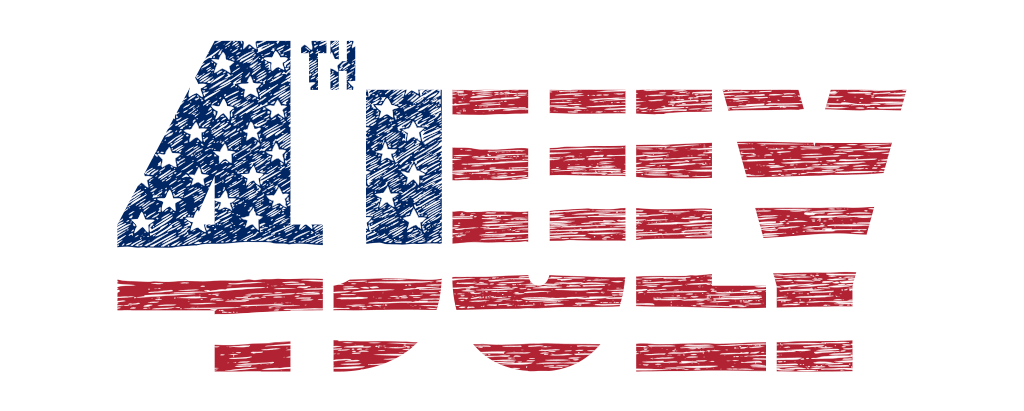
10 Unusual Facts about the 4th of July
Grilling out, playing yard games, and watching fireworks are activities we look forward to on the 4th of July.
While many of the 2020 firework celebrations have been canceled–the 4th of July isn’t. We’ve been celebrating our great nation’s Independence Day since 1776, and we aren’t stopping this year.
Our celebrations this year may be smaller and less noisy, but we can still take time to remember the freedom we enjoy.
Keep reading for 10 unusual facts about the 4th of July that are perfect for sharing with family around the grill.
#1 July 4th Wasn’t Always a Federal Holiday

While history recognizes the 4th of July as Independence Day, the U.S. government did not declare it a federal holiday until 1870.
The 4th of July did not become a national holiday until almost 100 years after the Declaration of Independence was signed. And, it was actually part of a bill that declared several national holidays, including Christmas.¹
#2 The Declaration of Independence Wasn’t Signed on July 4

On the 4th of July, we celebrate the signing of the Declaration of Independence.
According to the National Archives, “July 2, 1776, is the day that the Continental Congress actually voted for independence. […] The written Declaration of Independence was dated July 4 but wasn’t actually signed until August 2.”²
While July 2, 1776, was the day the Continental Congress voted for independence, it was on July 4, 1776, that the Continental Congress formally adopted the Declaration of Independence.
That is why we consider the 4th as America’s Independence Day.³
#3 Not Everyone Wanted to Celebrate on July 4th

As we explained above, July 2, 1776, was the day the Continental Congress voted for independence – not July 4. That’s why John Adams was adamant that July 2 should be celebrated rather than July 4.
In his excitement over the vote for independence, Adams wrote to his wife that July 2 would be celebrated throughout American history with “with Pomp and Parade, with Shews, Games, Sports, Guns, Bells, Bonfires and Illuminations from one End of this Continent to the other from this Time forward forever more.”⁴
According to History, “John Adams believed that July 2 was the correct date on which to celebrate the birth of American independence, and would reportedly turn down invitations to appear at July 4th events in protest.”⁵
#4 John Hancock Was the First to Sign the Declaration of Independence

The saying, “Put your John Hancock here,” comes from John Hancock’s large signature on the Declaration of Independence.
As Biography explains, “Hancock left a sizable signature with flourish; the idea of leaving one’s ‘John Hancock’ on paperwork has meaning to this day.”⁶
Hancock was the President of the Congress. As a result, he was the first person to sign the Declaration of Independence.
#5 Pennsylvania Evening Post First to Print the Declaration of Independence

On July 6, 1776, the Pennsylvania Evening Post was the first newspaper to publish the Declaration of Independence for Americans to read.⁷
#6 Three American Presidents Died on the 4th of July

In a sad twist of fate, John Adams and Thomas Jefferson both died on July 4, 1826, which was also the 50th anniversary of the adoption of the Declaration of Independence.
Constitution Facts explains, “The deaths of Thomas Jefferson and John Adams on July 4, 1826, may even have helped to promote the idea of July 4 as an important date to be celebrated.”⁸
A few years later, on July 4, 1831, James Monroe passed away.
#7 – The First Annual Commemoration of the 4th of July Took Place in Philadelphia

Americans started celebrating following the adoption of the Declaration of Independence with the first annual commemoration taking place on July 4, 1777, in Philadelphia.
In addition to public readings of the Declaration of Independence, Americans celebrated with bonfires and parades. And, fireworks, of course.
Our fireworks tradition stems from this first annual commemoration where multiple ships used their cannons to fire off a thirteen-gun salute to honor the thirteen colonies.⁹
#8 Massachusetts Was the First to Declare July 4th a State Holiday

While the first big celebration took place in Philadelphia, Massachusetts was actually the first state to declare July 4th a state holiday.
On July 3, 1781, Massachusetts passed legislation declaring July 4, “The anniversary of the independence of the United States of America” and made it an official state holiday.¹⁰
#9 George Washington Celebrated the Occasion with His Troops

Even during Revolutionary War battles, George Washington still found a way to celebrate America’s Independence Day. On July 4, 1778, Washington ordered a double ration of rum for his soldiers and a cannon salute.¹¹
#10 The Liberty Bell Tradition Continues Today

There is a long-held tradition of tolling the Liberty Bell on the 4th of July. This tradition continues every 4th of July with descendants of signers of the Declaration of Independence.¹⁴ symbolically tapping the Liberty Bell thirteen times.¹²
Speaking of descendants of the signers, the actress Reese Witherspoon is a direct descendant.
Her ancestor John Witherspoon was one of the original 56 signers of the Declaration of Independence.¹⁴.
Sources:
- https://www.constitutionfacts.com/us-declaration-of-independence/fourth-of-july/
- https://www.archives.gov/press/press-releases/2005/nr05-83.html
- https://www.history.com/topics/holidays/july-4th
- http://www.masshist.org/digitaladams/archive/doc?id=L17760703jasecond
- https://www.history.com/topics/holidays/july-4th
- https://www.biography.com/political-figure/john-hancock
- https://www.amrevmuseum.org/collection/first-newspaper-printing-declaration-independence
- https://www.constitutionfacts.com/us-declaration-of-independence/fourth-of-july/
- https://www.history.com/news/july-4-fireworks-independence-day-john-adams
- http://mastatelibrary.blogspot.com/2016/07/happy-independence-day-america.html
- https://www.history.com/topics/holidays/july-4th
- https://www.ushistory.org/libertybell
- https://www.archives.gov/press/press-releases/2005/nr05-83.html








